Strategy Implementation Project Group 12 Dabur India PDF

| Title | Strategy Implementation Project Group 12 Dabur India |
|---|---|
| Author | Anonymous User |
| Course | Retail management |
| Institution | Bangalore University |
| Pages | 14 |
| File Size | 722.1 KB |
| File Type | |
| Total Downloads | 81 |
| Total Views | 150 |
Summary
Strategy Framework...
Description
STRATEGY IMPLEMENTATION PROJECT GROUP 12 DABUR INDIA GROUP MEMBERS ₪ PRIYADHARSHINI LOBOW ₪ PUSHPARAJ SELVARAJ ₪ RAGHAVAN KEERTHIVASAN ₪ PRASHANT MS ₪ SESHAGIRI MANOJ KUMAR ₪ ARJUN MYLSAMY ₪ HORATIO ₪ KUSHAGRA ₪ SOUNAK ₪ SIVANESWARAN 1
Table of Contents
1. About Dabur India..................................................................................................................3 2. Products ................................................................................................................................4 3. Strategic Problems Faced By Dabur....................................................................................5 4. Competitor Analysis..............................................................................................................7 5. Decline In Market Share .......................................................................................................8 6. Financial Performance..........................................................................................................9 7. FCMG Industry LookUp…………………………………………………………………………… 11 8. How is Dabur Solving the Problem………………………………………………………………12 9. The Way Forward……………………………………………………………………………………13
2
About Dabur India Dabur India is a household name in the Indian subcontinent, a leader in the natural foods and ayurvedic industry. Armed with around 135 years of experience and quality since its incorporation in 1884, Dabur India Limited is the largest Ayurvedic and natural health care company in the world with a product range of more than 250+ herbal and ayurvedic items. Dabur India enjoys an accumulated sales volume of over Rs 80,000 crore with annual returns of Rs 8,700 crore. Dabur India’s portfolio of products range across hair care, oral care, health care, skincare, home care, and packaged foods. They are structured into three distinct divisions for optimizing operations and product management, namely, Goods for Health Care, Family Products, & Dabur Ayurvedic Specialties. Dabur products are sold in around 100 countries across the globe including Asia, Africa, the Middle East, US and Europe. It is the fourth Largest FMCG Company in India, headquartered in Ghaziabad with Mohit Malhotra as the CEO. In 1919, Dabur established its dedicated research laboratory for Ayurvedic medicines, a first in the country. Since then, it has been a great journey of innovation and diversification. Launch of ‘Dabur Amla Hair Oil’ in 1940, the country’s first branded and packaged ‘Chyawanprash’ in 1949 and Ayurvedic digestive medicine Hajmola in 1978 bear witness to the Dabur’s pursuit of innovation and diversification. These timeless and iconic products from the brand, catapulted Dabur into an elite club.
3
Products Dabur has a strong portfolio of products with more than 400 trusted products and over 1,000 SKUs. Dabur has put in place a Power Brand strategy in order to provide adequate focus and investment to its key brands. Dabur has identified nine Power Brands, which accounts for well over 70% of its total Sales of products. Dabur Chyawanprash, Dabur Lal Tail, Dabur Pudin Hara, Dabur Amla Hair Oil, Dabur Honey, Dabur Honitus, Dabur Red Paste, Vatika and Real fruit juice – are the nine Power Brands of Dabur.
Strategic problem faced by Dabur
4
Dabur India was facing stiff challenges with eroding customer base driven by changing customer preferences and new entrants in the market. The table below illustrates the strengths|weaknesses | opportunities and threats faced by Dabur. SWOT Analysis + BSC
Criterion
Strengths
Financials
Strong brands driving financial results
Customers
Loyal customer base for some iconic products such as Chyawanprash, Hajmola, Vatika Hair Oil
Weaknesses Declining market share due to increasing competition
Brand and products not popular among youth.
Opportunities Revived interest in ayurvedic products due to Patanjali’s entry
Many big FMCG players such as Colgate Palmolive, Unilever entering the ayurvedic products market
Growing interest in ayurvedic products amongst urban population Rural customer base
Low switching costs for the FMCG products Fragmented market with multiple players
Marketing spend is not in New line of ayurvedic par with competition Wide distribution network products in the luxury Technology adoption and Internal Processes Global expansion in segment online presence select markets Marketing investment in specifically is not in par strong brands with competition. Marketing team not Build a strong and strongly positioned to creative marketing team Strong leadership team compete with other People Hire experts to build Strong sales team market leaders online presence Rural sales team is not strong The table below summarizes the strategic issues faced by Dabur and comments based on the analysis. 5
Threats
Aggressive marketing strategy from competitors Early bird advantage that competitors enjoy on the online sales platform High churn rate in the industry for critical talent particularly in marketing and sales
Strategic issues
Analysis
Consumer Preference in Urban Areas
Urban areas had low switching cost Brand considered being for old people. Urban areas to be focussed with brand awareness and high level aggressive marketing
Very Low Investments in Marketing Compared to P&G, Unilever
Strategic spending for brand building and awareness to be done in Urban areas
Not Leveraging Technologies as Compared to the Competition
Need more focus on online presence for both marketing and sales? Technology adoption in customer management and operations will help drive efficiency.
Product Portfolio Not Broad
Dabur should spend more in R&D developing new products in different categories.
Globalization Efforts Not Aggressively Pursued
Dabur needs to target the population in developed markets like north America and Europe
Low Demand with High Competition
Initially Dabur faced low demand and high competition. Outsourcing non-core activities helped Dabur to focus on core products and their quality like Fruit juices, tooth paste, skin care
Competitor Analysis 6
Dabur cannot not afford to have a single strategy to compete against its competitors effectively. It operates in the highly competitive FMCG industry consisting of large MNCs, such as HUL, P&G, PATANJALI, ITC, etc. It cannot afford to go for purely offensive strategies that directly affect the bottom line and will trigger price wars. Moreover, the basic nature of the marketplace is dynamic. The deciding criteria for any policy adoption is that it should be based on the company’s strength, clear sustainable competitive advantage, and consumers’ needs and requirements. ₪
Dabur has a very strong and wide supply chain network that covers both rural and urban areas through 600+ distributors & 2.8 million retailers. This network has helped Dabur reach every corner of India, which gives it a competitive edge over its competitors like HUL, P&G, ITC, Patanjali etc.
₪
The FMCG space is overcrowded and fragmented due to the presence of multiple domestic and international players. Dabur has multiple brands in its portfolio with varying brand value and market penetration. While some of the brands are quite strong in their product segment, some are not.
₪
While Dabur targets all customer segments, like other companies, middle-class customer segment is the most critical group for Dabur.
₪
Despite their superior positioning in ayurvedic and natural health care products in rural areas and semi-urban regions, there are issues Dabur faces due to consumer preferences in the urban areas.
₪
In addition, the low switching costs for consumers adds to the complexity of Dabur’s problems.
₪
Dabur’s investment in marketing and branding is relatively low as compared to its competitors.
₪
Strategic spending for brand building, awareness and promotional activities to be done in order to aggressively market its products.
Technology automation to leverage operational efficiencies would help in achieving superior competitive advantage compared to the top rivals. Decline in Market Share ₪
7
Baba Ramdev’s Patanjali Ayurveda stormed the ayurvedic FMCG market and created a flutter. Dabur saw its market share decline in most product categories with the new entrant. By 2020, Patanjali’s impact weathered however, Dabur continues to face the headwinds of demand slowdown and the situation is expected to persist for a while. “The near-term outlook for demand growth remains challenging with most key categories reporting a steady decline in Value and Volume growth,” Mohit Malhotra, Chief Executive Officer, Dabur, said in a statement. Dabur reported a single-digit 7% jump in revenue and double digit of 10.7% growth in operating margin during 3QFY20. Share of Dabur products across India in FY 2020, by category
FMCG Market Share 2020 - India 12.00%
10.00%
48.00% 7.00%
5.00% 4.00% 3.00% 2.00% 2.00% ITC Patanjali Dabur
HUL Amul Godrej
4.00% 3.00%
Parle Products Nestle Others local players
Marico Britania
Source - https://en.wikipedia.org/wiki/FMCG_in_India Financial Performance 8
Growth Trajectory ₪ Dabur reported a jump of 34.4% in their consolidated net profit to Rs.377.80 crores on 25.3% rise in revenue from operations to Rs.2,336.80 crores in Q4 FY21 over Q4 FY20. ₪ The company's healthcare products reported a strong 23% growth in Q4 with the – o o o o
Ayurvedic business growing by 39.1% OTC business reporting a growth of 34% The Digestives business growing by 20% and The Health Supplements category with a nearly 18% growth.
₪ Dabur's financial situation remains strong with a 25.6% growth in their Operating Profit during Q4 2020-21. ₪ The India FMCG Business led the growth with a 28.3% surge; with an underlying, best-ever FMCG Volume Growth of 25.4% during the fourth quarter of 2020-21. YoY Revenue Comparison (FY’11 thru’ FY’20)
9
FMCG Industry Look-Up
10
The Fast-moving Consumer Goods (FMCG) sector is that the fourth largest sector of the Indian economy. During FY2019-20, FMCG sector witnessed a growth of 7.2% as per AC Nielsen, which is sort of half of the 14% growth reported in FY2018-19. The FMCG sector saw a sharp slowdown during the year because of moderation in economic activity, low farm incomes and weak rural wage growth, liquidity crunch within the system, high unemployment levels and downtrading across categories. By March 2020, the industrial growth dropped to 3.3% in value terms and 0.5% in volume terms. The Corona virus pandemic has further influenced the industry since March 2020 because of restrictions on movement of products, supply side bottlenecks and impact on consumption. Consumers are stocking up essential products like packaged foods, staples, tea, coffee, milk, detergents, and other products of daily usage. In this phase, demand has also surged for health and hygiene products as these aspects came into sharp focus. There was a sharp surge in demand for hygiene products like sanitizers and disinfectants in addition to immunity building OTC and healthcare products. However, discretionary and nonessential items have seen weak demand because the focus during the lockdown has been on food and hygiene. The FMCG landscape is undergoing a transmutation with the emergence of COVID-19, which is also affecting consumer behaviour across markets and geographies. The subsequent consumer trends are expected to pick up in the post-COVID world: ₪ Increased consumer focus on healthcare, particularly preventive healthcare, with a preference for Ayurveda based solutions that boost immunity ₪ Greater focus on Personal Hygiene with huge demand for hand and home sanitisers expected to grow exponentially ₪ Discretionary spending would be curtailed because of a shift of priorities towards essentials ₪ Movement towards financial security to achieve momentum ₪ Technology to act as a catalyst for convenience, safe and enhanced consumer experiences
11
How is Dabur Solving the Problem? A positive impact of the new entrant Patanjali and its dramatic and aggressive marketing strategy was that there an increasing awareness of ayurvedic product in the FMCG segment. The demand for ayurvedic FMCG products increased in both urban and rural markets. Customers started looking at ayurvedic products beyond medicines. While all the FMCG players scrambled to exploit this new opportunity, Dabur realized that, it was strongly positioned as India’s custodian of Ayurveda to make the most of it. Dabur Adopted a Multifaceted Growth Strategy Narrow the focus from a diverse portfolio of products to 9 brands to grow during the pandemic. The power of nine strategy 1
focuses on the 9 brands (Dabur Chyawanprash, Dabur Honey, Dabur Honitus, Dabur PudinHara, Dabur Lal Tail, Dabur Amla, Dabur Red Paste, Real and Vatika) which together contribute to more than 1000 crore INR in sales. The strategy is to allocate a higher proportion of marketing spend on these power brands and launch product extensions. For
2
3 4 5 6
7
example, sugar free Chyawanprash, Dabur red pulling oil in the oral care segment and Dabur Badaam Amla hair oil in the personal care segment. Focused its operations on its core strength, which is manufacturing high quality and cost efficient products. It decided to outsource its non-core operational activities such as IT. Dabur redesigned its packaging and presentation of its products to attract the young aspiring population Dabur embarked on a path of inorganic growth through mergers and acquisitions Dabur identified rural market as a potential growth driver. It chalked out plans to for this market and invested heavily in the distribution network for the rural market. The portfolio for rural market was divided into personal care and healthcare. 400 people were added to strengthen its sales and distribution workforce for the rural areas. Dabur started its global expansion, first targeting the Indian Diaspora with its iconic products. Later started catering to the nonIndian consumers as well with customized products such as Olive oil based hair care products in Middle East. Recognizing the significance of the ecommerce platform and its glaring gap in this space, Dabur created a separate team for e-
8
commerce. Dabur launched a set of new e-commerce first products such as the baby care range and premium shampoo range
9
under Vatika select. Dabur has increased its domestic advertisement spend by 50% in the recent past. This gave the much-needed boost for its go to 12
10
11
12 13 14 15 16
market strategy. Renewed focus on innovation saw the launch of new products in the hygiene space such as floor cleaners, disinfectants. New immunity boosting products such as churanas, Tulsi health drops exploited the new opportunities brought in by the pandemic. Food and beverages segment was identified as a growth opportunity as the ready to cook and ready to eat category consumption increased with the pandemic. The Homemade brand is being expanded beyond chutneys and pickles into spices and condiments. Fresh investments in infrastructure. Dabur is setting up a green field facility in Madhya Pradesh and revamping its existing manufacturing plants to cater to the demands. Investing in operational efficiencies. Dabur implemented a Continuous Replenishment System (CRS) to manage its inventory and improve the turnaround time for stock replenishment. “Ghar Ghar Ayurveda” retail initiative focused on increasing its sales footprint by adding stores and increasing shelf space in major outlets. Project Samarridhi was kicked off to drive cost savings across its value chain. This led to cost savings of around 50 crores INR. Dabur is also rapidly increasing its total land under cultivation from 2000 acres to 4500 acres to become India’s largest cultivator of rare medicinal plants
Conclusion - The Way Forward Dabur needs to keep the throttle on its renewed focus and go to market strategy to sustain the momentum it has gained. The multinational players such as HUL, CG are making big investments in the Ayurveda segments and the market is expected to get more competitive. In this light, ₪ Dabur needs to strongly ascertain its Custodian of Ayurveda” brand image. 13
₪ Dabur will also need to extend its globalization efforts middle east to North America and UK where the Indian diaspora is widely spread.
₪ Diversify its food and beverages product segment to capture the consumer segment in cities that is striving to reach a balance between eating healthy and not spending too much time in kitchens ₪ Continue to aggressively pursue ecommerce platforms and build on its online presence
14...
Similar Free PDFs

case study on Dabur India Ltd cmpany
- 22 Pages

F9 Strategy Implementation
- 17 Pages
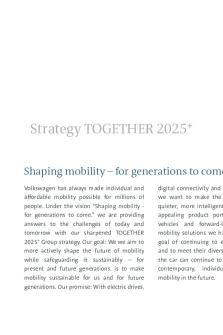
Strategy Volkswagen Group
- 1 Pages
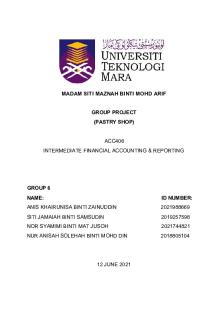
Group Project Account ( Group 6)
- 21 Pages

Business Strategy Project Capsim
- 3 Pages
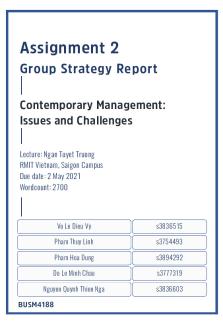
Group Strategy Report Team 1
- 16 Pages
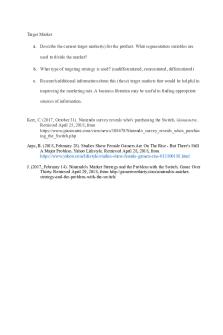
Group Project- Target Market
- 4 Pages
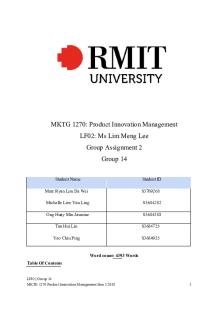
PIM Group Project 2
- 68 Pages
Popular Institutions
- Tinajero National High School - Annex
- Politeknik Caltex Riau
- Yokohama City University
- SGT University
- University of Al-Qadisiyah
- Divine Word College of Vigan
- Techniek College Rotterdam
- Universidade de Santiago
- Universiti Teknologi MARA Cawangan Johor Kampus Pasir Gudang
- Poltekkes Kemenkes Yogyakarta
- Baguio City National High School
- Colegio san marcos
- preparatoria uno
- Centro de Bachillerato Tecnológico Industrial y de Servicios No. 107
- Dalian Maritime University
- Quang Trung Secondary School
- Colegio Tecnológico en Informática
- Corporación Regional de Educación Superior
- Grupo CEDVA
- Dar Al Uloom University
- Centro de Estudios Preuniversitarios de la Universidad Nacional de Ingeniería
- 上智大学
- Aakash International School, Nuna Majara
- San Felipe Neri Catholic School
- Kang Chiao International School - New Taipei City
- Misamis Occidental National High School
- Institución Educativa Escuela Normal Juan Ladrilleros
- Kolehiyo ng Pantukan
- Batanes State College
- Instituto Continental
- Sekolah Menengah Kejuruan Kesehatan Kaltara (Tarakan)
- Colegio de La Inmaculada Concepcion - Cebu







